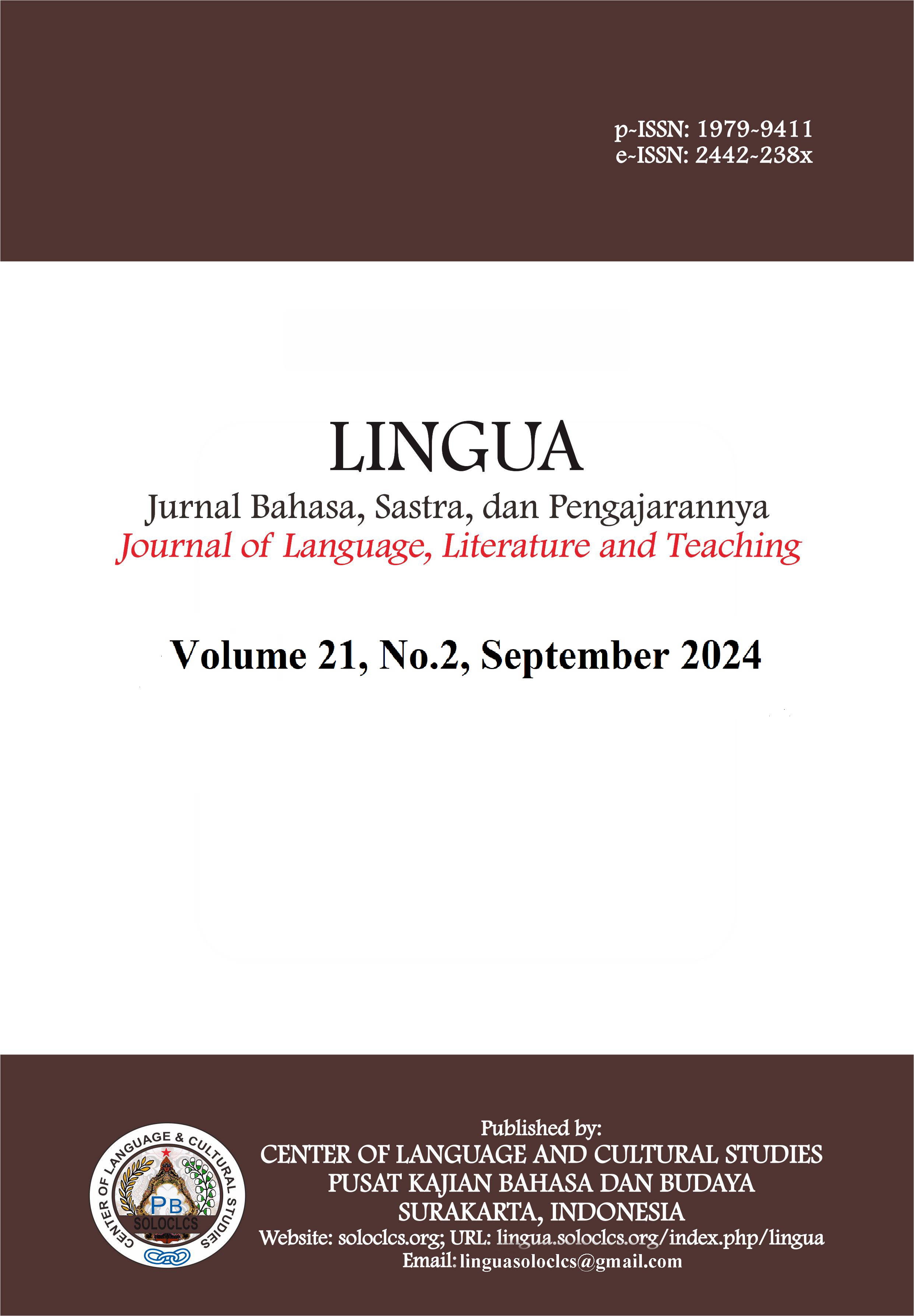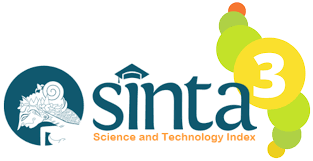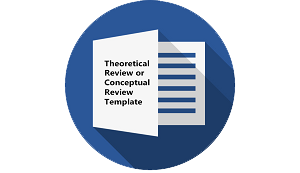Social Media Sociolinguistics: Patterns, Trends, And The Dynamics Of Digital Language
DOI:
https://doi.org/10.30957/lingua.v21i2.1050Keywords:
Keywords: Digital language, interaction, patterns, trends, dynamics of social mediaAbstract
The development of digital technology has changed a person's mindset in communicating, especially in terms of social media. This study examines the mindset, trends and dynamics of digital language in the context of social media. The purpose of this study explores how digital language influences social media, including the use of words, language and the dynamics of interaction between social media users. The analysis method used in this study is a literature review, covering various reference sources that are in accordance with the topic discussed. The results of the analysis show that social media has unique patterns and trends, which are influenced by many factors such as cultural background, gender to age and the interaction of social media users can affect language development.
Downloads
References
Alalawneh, A. A., Al-Omar, S. Y. S., & Alkhatib, S. (2022). The Complexity of Interaction between Social Media Platforms and Organizational Performance. Journal of Open Innovation: Technology, Market, and Complexity, 8(4), 169. https://doi.org/10.3390/joitmc8040169
Alida Volkmer, S., & Meißner, M. (2024). Beyond livestreaming: The rise of social media gifting and paid memberships − A systematic literature review and future research agenda. Journal of Business Research, 185(August). https://doi.org/10.1016/j.jbusres.2024.114915
Bonati, S., Nardini, O., Boersma, K., & Clark, N. (2023). Unravelling dynamics of vulnerability and social media use on displaced minors in the aftermath of Italian earthquakes. International Journal of Disaster Risk Reduction, 89(August 2022), 103632. https://doi.org/10.1016/j.ijdrr.2023.103632
Boota, M. W., Soomro, S. e. hyde., Ahmad, M. I., Khan, S., Xia, H., Qin, Y., Yan, C., Xu, J., Yousaf, A., Boota, M. A., & Ahmed, B. (2024). Integrating social media and deep learning for real-time urban waterlogging monitoring. Journal of Hydrology: Regional Studies, 56(October), 102070. https://doi.org/10.1016/j.ejrh.2024.102070
Chan, W. W., Advani, R. R., Bilal, M., Charabaty, A., Kwok, K. K., Laster, J. S., Perelman, A., Siddique, S. M., Trieu, J., Umoren, M. D., & Chiang, A. L. (2024). American Society for Gastrointestinal Endoscopy best practice statements on the sharing of endoscopic images and videos on social media. VideoGIE, 9(10), 425-432.e1. https://doi.org/10.1016/j.vgie.2024.08.008
Cho, S. H., Kim, D., Kwon, H. C., & Kim, M. (2024). Exploring the potential of large language models for author profiling tasks in digital text forensics. Forensic Science International: Digital Investigation, 50(S), 301814. https://doi.org/10.1016/j.fsidi.2024.301814
Chowdhury, M., Dixon, L., Kuo, L.-J., Donaldson, J. P., Eslami, Z., Viruru, R., & Luo, W. (2024). Digital game-based language learning for vocabulary development. Computers and Education Open, 6(January), 100160. https://doi.org/10.1016/j.caeo.2024.100160
Czakon, W., Mania, K., Jedynak, M., Kuźniarska, A., Choiński, M., & Dabić, M. (2024). Who are we? Analyzing the digital identities of organizations through the lens of micro-interactions on social media. Technological Forecasting and Social Change, 198(March 2023). https://doi.org/10.1016/j.techfore.2023.123012
Dashti, F., & Abdulsalam, H. M. (2025). The influence of social media applications on learning English as a second language. Heliyon, 11(2), e41874. https://doi.org/10.1016/j.heliyon.2025.e41874
Davies, A., D’Cruze, N., Senni, C., & Martin, R. O. (2022). Inferring patterns of wildlife trade through monitoring social media: Shifting dynamics of trade in wild-sourced African Grey parrots following major regulatory changes. Global Ecology and Conservation, 33(September 2021), e01964. https://doi.org/10.1016/j.gecco.2021.e01964
dos Santos e Santos, L., Ribeiro Filho, P. R. C. F., & Macêdo, E. N. (2024). Belt rotation in pipe conveyors: Development of an overlap monitoring system using digital twins, industrial Internet of things, and autoregressive language models. Measurement: Journal of the International Measurement Confederation, 230(March). https://doi.org/10.1016/j.measurement.2024.114546
Feng, T., Wang, B., Mi, M., Ren, L., Wu, L., Wang, H., Liu, X., & Wang, X. (2025). The relationships between mental health and social media addiction, and between academic burnout and social media addiction among Chinese college students: A network analysis. Heliyon, 11(3), e41869. https://doi.org/10.1016/j.heliyon.2025.e41869
Garay Gallastegui, L. M., & Reier Forradellas, R. (2024). FASECO: A Framework for Advanced Support of E-Commerce and digital transformation in SMEs with natural language processing-enhanced analysis. Journal of Open Innovation: Technology, Market, and Complexity, 10(4). https://doi.org/10.1016/j.joitmc.2024.100412
Ghenai, A., Noorian, Z., Moradisani, H., & Abadeh, P. (2025). Exploring hate speech dynamics : The emotional , linguistic , and thematic impact on social media users. Information Processing and Management, 62(3), 104079. https://doi.org/10.1016/j.ipm.2025.104079
Gindil, H., Backer, A., & Awad, I. (2025). The extensive use of social media by Arab university students ( gratifications , impact , and risks ). Entertainment Computing, 53(August 2024), 100926. https://doi.org/10.1016/j.entcom.2025.100926
Grieser, I. N., Gebhard, T., Tundis, A., Kersten, J., Elßner, T., & Steinke, F. (2025). Modeling and monitoring social media dynamics to predict electricity demand peaks. Energy Reports, 13(November 2024), 1548–1557. https://doi.org/10.1016/j.egyr.2024.12.065
Grupp, K., Blessmann, M., König, H. H., & Hajek, A. (2025). Frequency of probable social media addiction and correlates of problematic social networking sites use in a sample of transgender adults. Heliyon, 11(1). https://doi.org/10.1016/j.heliyon.2025.e41674
Hamilton, J. L., Untawale, S., Dalack, M. N., Thai, A. B., Kleiman, E. M., & Yao, A. (2025). Jo. JAACAP Open. https://doi.org/10.1016/j.jaacop.2024.11.008
Hasan, M., & Al-abyadh, A. (2025). Heliyon The fear of missing out and social media addiction : A cross-sectional and quasi-experimental approach. Heliyon, 11(3), e41958. https://doi.org/10.1016/j.heliyon.2025.e41958
Hathat, Z. El, Venkatesh, V. G., Raja Sreedharan, V., Zouadi, T., Shi, Y., & Arunmozhi, M. (2025). Stakeholder engagement in carbon reduction engineering: A perspective analysis of production optimization leveraging social-media interactions. Computers and Industrial Engineering, 200(December 2024), 110807. https://doi.org/10.1016/j.cie.2024.110807
He, J., Lin, Y., Hooimeijer, P., & Monstadt, J. (2024). Informal participation in digital planning: How can third parties use social media to shift power relations in planning? Computers, Environment and Urban Systems, 114(August), 102193. https://doi.org/10.1016/j.compenvurbsys.2024.102193
Kim, J., & López Sintas, J. (2021). Social TV viewers’ symbolic parasocial interactions with media characters: A topic modelling analysis of viewers’ comments. Social Sciences and Humanities Open, 3(1). https://doi.org/10.1016/j.ssaho.2021.100129
Kruiper, R., Kumar, B., Watson, R., Sadeghineko, F., Gray, A., & Konstas, I. (2024). A platform-based Natural Language processing-driven strategy for digitalising regulatory compliance processes for the built environment. Advanced Engineering Informatics, 62(PB), 102653. https://doi.org/10.1016/j.aei.2024.102653
Kurten, S., Ghai, S., Odgers, C., Kievit, R., & Orben, A. (2023). Deprivation’s role in adolescent social media use and its links to life satisfaction. Computers in Human Behavior, 165(December 2024), 108541. https://doi.org/10.1016/j.chb.2024.108541
Lee, J., & Kim, S. (2024). Engaging with underserved communities during times of crises: A computational analysis of social media interactions with government information about COVID-19 economic relief programs. Telematics and Informatics, 95(October), 102209. https://doi.org/10.1016/j.tele.2024.102209
Li, X., Tse, Y. K., & Bu, X. (2025). Examining corporate social irresponsibility in manufacturing: An eye-tracking study of social media news. International Journal of Production Economics, 281(April 2024), 109539. https://doi.org/10.1016/j.ijpe.2025.109539
Lu, H., Zhang, S., Gao, Y., Jin, H., Zhao, P., Gao, Y., Li, Y., Wang, W., & Zhang, Y. (2025). Using social media data to construct and analyze knowledge graph for “7.20” Henan rainstorm flood event. International Journal of Disaster Risk Reduction, 116(November 2024), 105129. https://doi.org/10.1016/j.ijdrr.2024.105129
Mathers, S. J., Kolancali, P., Jelley, F., Singh, D., Hodgkiss, A., Booton, S. A., Malmberg, L., & Murphy, V. A. (2025). Features of digital media which influence social interactions between adults and children aged 2 – 7 years during joint media engagement : A multi-level meta-analysis. Educational Research Review, 46(June 2024), 100665. https://doi.org/10.1016/j.edurev.2025.100665
Mazhar, B., Niu, J., Zhong, Q., & Haq, I. U. (2024). Unraveling the dynamics of COVID-19 fake news spread: The influence of socialization, entertainment, and altruism in instant news sharing on social media. Telematics and Informatics Reports, 15(May), 100155. https://doi.org/10.1016/j.teler.2024.100155
Mehra, V., Singh, P., Bharany, S., & Sawhney, R. S. (2023). A social media analytics application of impression management and social presence theories to Twitter interaction analysis. Decision Analytics Journal, 9(September), 100321. https://doi.org/10.1016/j.dajour.2023.100321
Miao, B. Y., Sushil, M., Xu, A., Wang, M., Arneson, D., Berkley, E., Subash, M., Vashisht, R., Rudrapatna, V., & Butte, A. J. (2024). Characterisation of digital therapeutic clinical trials: a systematic review with natural language processing. The Lancet Digital Health, 6(3), e222–e229. https://doi.org/10.1016/S2589-7500(23)00244-3
Michelet, G., & Breitinger, F. (2024). ChatGPT, Llama, can you write my report? An experiment on assisted digital forensics reports written using (local) large language models. Forensic Science International: Digital Investigation, 48(March). https://doi.org/10.1016/j.fsidi.2023.301683
Muawanah, U., Marini, A., & Sarifah, I. (2024). The interconnection between digital literacy, artificial intelligence, and the use of E-learning applications in enhancing the sustainability of Regional Languages: Evidence from Indonesia. Social Sciences and Humanities Open, 10(October), 101169. https://doi.org/10.1016/j.ssaho.2024.101169
Ng, P. M. L., Wut, T. M., Chan, J. K. Y., Lau, M. M., Cheung, C. T. Y., Kwok, M. L. J., & Choy, E. T. K. (2025). Exploring the role of internal social media in fostering employee green behavior (EGB). Sustainable Futures, 9(October 2024), 100425. https://doi.org/10.1016/j.sftr.2024.100425
Nurhadi, M., Suryani, T., & Fauzi, A. A. (2024). Cultivating domestic brand love through social media marketing activities: Insights from young consumers in an emerging market. Asia Pacific Management Review, xxxx, 100349. https://doi.org/10.1016/j.apmrv.2024.100349
Omar, H., & Lasrado, L. A. (2023). Uncover social media interactions on cryptocurrencies using social set analysis (SSA). Procedia Computer Science, 219(2022), 161–169. https://doi.org/10.1016/j.procs.2023.01.277
Ruggieri, S., Gagliano, M., Bonfanti, R. C., Cucinella, N., & Ingoglia, S. (2023). Interaction through social media: Development and validation of a social network site self-efficacy scale (SNS-SES). Acta Psychologica, 235(October 2022), 103889. https://doi.org/10.1016/j.actpsy.2023.103889
Shan, Y. (2025). Journal of Economic Behavior and Organization Disinformation in group chat social media network. Journal of Economic Behavior and Organization, 231, 106891. https://doi.org/10.1016/j.jebo.2025.106891
Shastry, K. A., & Shastry, A. (2023). An integrated deep learning and natural language processing approach for continuous remote monitoring in digital health. Decision Analytics Journal, 8(March), 100301. https://doi.org/10.1016/j.dajour.2023.100301
Shibuya, Y., Hamm, A., & Cerratto Pargman, T. (2022). Mapping HCI research methods for studying social media interaction: A systematic literature review. Computers in Human Behavior, 129(November 2021), 107131. https://doi.org/10.1016/j.chb.2021.107131
Smailhodzic, E., Boonstra, A., & Langley, D. J. (2021). Social media enabled interactions in healthcare: Towards a taxonomy. Social Science and Medicine, 291(September), 114469. https://doi.org/10.1016/j.socscimed.2021.114469
Smolev, E. T., Rolf, L., Zhu, E., Buday, S. K., Brody, M., Brogan, D. M., & Dy, C. J. (2021). “Pill Pushers and CBD Oil”—A Thematic Analysis of Social Media Interactions About Pain After Traumatic Brachial Plexus Injury. Journal of Hand Surgery Global Online, 3(1), 36–40. https://doi.org/10.1016/j.jhsg.2020.10.005
Tang, Y., Yan, Y., Mao, J., Ni, J., & Qing, H. (2023). Jo l P re of. Ageing Research Reviews, 101865. https://doi.org/10.1016/j.gimo.2025.102844
Teng, M. F. (2024). Metacognition and autonomy in building a community for language learning through VR digital gaming. Computers & Education: X Reality, 4(March), 100060. https://doi.org/10.1016/j.cexr.2024.100060
Tyrv, O. (2025). Telematics and Informatics Overloaded yet addicted ? A meta-analysis of the outcomes of social media overload. 98(February). https://doi.org/10.1016/j.tele.2025.102247
Vnucko, G., Kralova, Z., & Tirpakova, A. (2024). Exploring the relationship between digital gaming, language attitudes, and academic success in EFL university students. Heliyon, 10(13), e33301. https://doi.org/10.1016/j.heliyon.2024.e33301
Yu, B., & Wang, W. (2025). Using digital storytelling to promote language learning, digital skills and digital collaboration among English pre-service teachers. System, 129(October 2024), 103577. https://doi.org/10.1016/j.system.2024.103577
Zollo, S., Cinelli, M., Etta, G., Cerqueti, R., & Quattrociocchi, W. (2025). Inference of social media opinion trends in 2022 Italian elections. Expert Systems with Applications, 269(September 2024), 126377. https://doi.org/10.1016/j.eswa.2024.126377
Zrubcov, D. (2025). Nurse Education in Practice Social media behaviour and patterns of use among nursing students : A systematized review ˇ Dominika Kohanov a. 83(February), 0–2. https://doi.org/10.1016/j.nepr.2025.104277
Downloads
Published
How to Cite
Issue
Section
License
Authors who publish with this journal agree to the following terms:
- Authors retain copyright and grant the journal right of first publication with the work simultaneously licensed under a Creative Commons Attribution-ShareAlike 4.0 International License that allows others to share the work with an acknowledgement of the work's authorship and initial publication in this journal.
- Authors are able to enter into separate, additional contractual arrangements for the non-exclusive distribution of the journal's published version of the work (e.g., post it to an institutional repository or publish it in a book), with an acknowledgement of its initial publication in this journal.
- Authors are permitted and encouraged to post their work online (e.g., in institutional repositories or on their website) prior to and during the submission process, as it can lead to productive exchanges, as well as earlier and greater citation of published work (See The Effect of Open Access).















